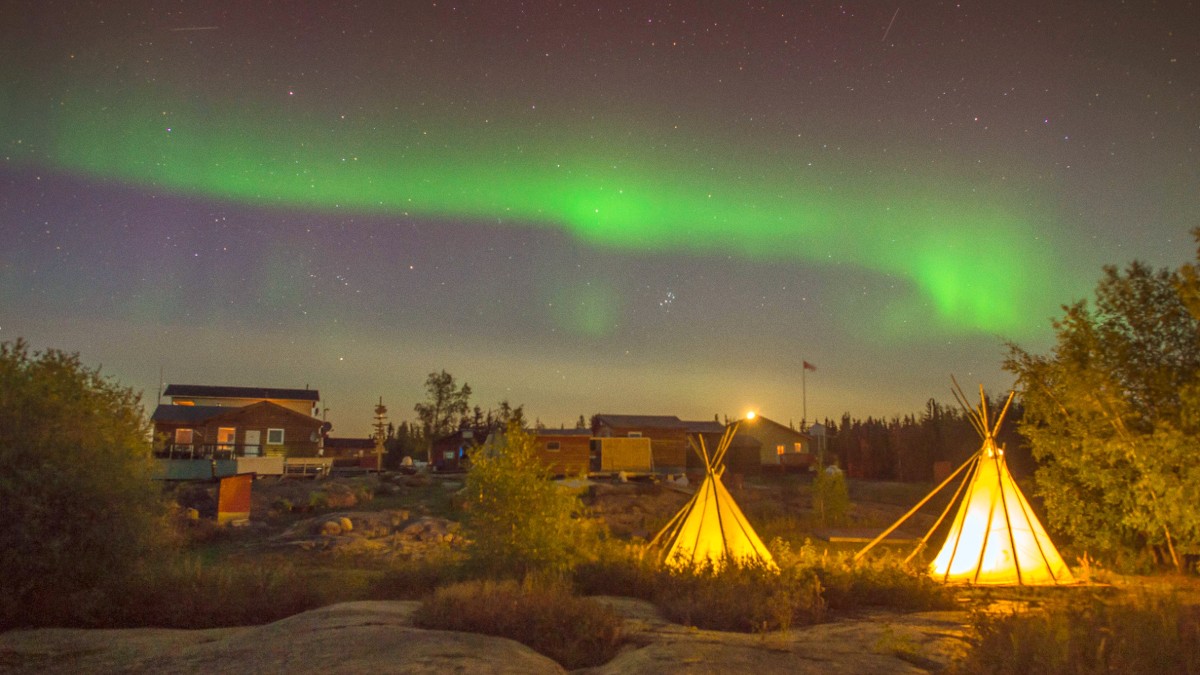
Northwest Territories, Canada
Dettah: A small Dene First Nation community located across Yellowknife Bay. Access via seasonal ice road in winter (typically late December to early April, ice thickness varies) or by boat or floatplane in summer.
Ingraham Trail (Highway 4): This highway extends over 70 km (43 miles) northeast of Yellowknife. It functions as an access point to a network of lakes, parks, and recreational areas. The trail is paved for the first portion then turns to gravel, with numerous access points for fishing, hiking, and camping.
The raw beauty of the Northwest Territories is readily accessible for day trips, with dramatic landscapes and outdoor activities.
Cameron River Falls Territorial Park: About 60 km (37 miles) east of Yellowknife along the Ingraham Trail. This park features scenic hiking trails leading to a beautiful waterfall, popular in summer and early fall.
Just outside Yellowknife, this park features a sandy beach, picnic areas, and short walking trails. It functions as a popular spot for locals and visitors alike in summer for swimming, relaxing, and enjoying the outdoors.
Beyond Yellowknife's city limits, opportunities for cultural experiences await in nearby communities.
Experience the contemporary Dene community of Dettah, accessible for respectful cultural engagement.
Discover interpretive signs along the Ingraham Trail about the region's trapping and early mining history.
Consider guided tours for cultural context and respectful engagement with local traditions.
Guided tours promote respectful engagement, understanding Dene traditions, and logistical support.
Independent travel with a rental car presents flexibility. Organized tours provide insights into the natural history, geology, and wildlife of the area, led by knowledgeable local guides.
For more time, consider extending your Yellowknife trip to explore other significant parts of the Northwest Territories or neighboring provinces.
Approximately 4.5-hour drive south of Yellowknife on Highway 3 and Highway 2. Known as the "Hub of the North," Hay River provides access to the mighty Mackenzie River. It functions as a good base for fishing, and a short drive brings you to Twin Falls Territorial Park, featuring the impressive Alexandra Falls and Louise Falls, which display spectacularly in both summer and winter.
Approximately 8-hour drive south of Yellowknife, or a short flight. Fort Smith is the gateway to Wood Buffalo National Park, Canada's largest national park and an UNESCO World Heritage Site. This park is the nesting grounds for the endangered whooping cranes and home to the world's largest free-roaming herd of wood bison.
Many travelers fly back to Edmonton, Calgary, or Vancouver to continue exploring other Canadian provinces. This presents a contrast to the Northern experience.
For a dive into the Arctic, consider flying further north or west via Canadian North flights to communities like Inuvik or Norman Wells. This presents different perspectives on Northern life and landscapes.
For adventurous travelers, longer regional trips present unique road trip experiences or Arctic exploration.
Drive the full length of the Mackenzie Highway (Hwy 1 & 3) south to Alberta for an unique summer road trip through diverse landscapes and small communities.
Some multi-day tours from Yellowknife or Inuvik present flights or drives across the Arctic Circle, officially entering the Arctic.
Experience the remote Northern terrain and isolated settlements by venturing on these longer drives.
Careful planning day trips and excursions from Yellowknife leads to memorable and safe experiences in the diverse Northern landscape.
Download offline maps for navigation, especially where mobile data coverage fades. Plot your route in advance.
Northern weather changes quickly. Monitor conditions before and during your trip, dressing appropriately.
Always bring water, snacks, extra layers, first-aid, and emergency supplies, especially for longer excursions.
Carry out all trash, including organic waste. Use designated bins where available.
Keep a safe distance from wildlife. Never feed animals or disturb their habitats.
Stick to marked trails to protect fragile ecosystems and minimize your footprint.